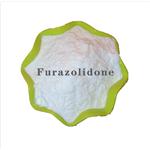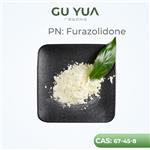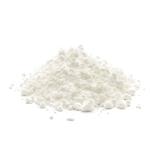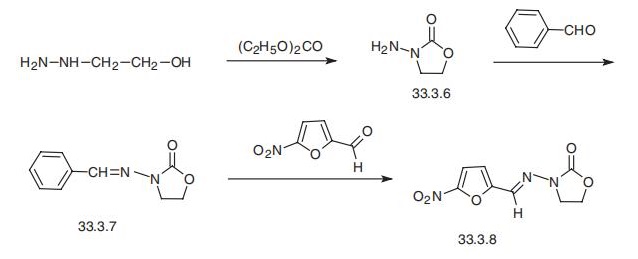- Furazolidone
-

- $80.00 / 1kg
-
2024-03-22
- CAS:67-45-8
- Min. Order: 1kg
- Purity: 99%
- Supply Ability: 20000tons
- Furazolidone
-

- $10.00 / 1kg
-
2024-03-08
- CAS:67-45-8
- Min. Order: 1kg
- Purity: 99%
- Supply Ability: 1000kg
- Furazolidone hcl
-

- $0.00 / 10kg
-
2024-02-13
- CAS:67-45-8
- Min. Order: 10kg
- Purity: 99% purity
- Supply Ability: 1000 kg
Related articles - Uses of Furazolidone
- This nitrofuran has in vitro activity against S. aureus, S. pyogenes, Enterococcus faecalis, E. coli, Vibrio cholerae, Clostri....
- Mar 10,2022
|
| | Furazolidone Chemical Properties |
| Melting point | 254-256°C (dec.) | | Boiling point | 366.66°C (rough estimate) | | density | 1.5406 (rough estimate) | | refractive index | 1.7180 (estimate) | | Fp | 2 °C | | storage temp. | Keep in dark place,Sealed in dry,Room Temperature | | solubility | formic acid: soluble50mg/mL | | pka | -1.98±0.20(Predicted) | | form | powder | | color | yellow | | λmax | 365nm(DMSO)(lit.) | | Sensitive | Light Sensitive | | Merck | 14,4300 | | BRN | 8317414 | | Stability: | Stable. Combustible. Incompatible with strong oxidizing agents. | | InChIKey | PLHJDBGFXBMTGZ-UITAMQMPSA-N | | IARC | 3 (Vol. 31, Sup 7) 1987 | | NIST Chemistry Reference | Furazolidone(67-45-8) | | EPA Substance Registry System | Furazolidone (67-45-8) |
| | Furazolidone Usage And Synthesis |
| Antibacterials | Furazolidone is a kind of nitrofuran-class antibacterial agents which has certain antibacterial effects on gram positive and negative bacteria including Salmonella, Shigella, Escherichia coli, Klebsiella pneumoniae Peter, Enterobacter spp., Staphylococcus aureus, Enterococcus faecalis, Streptococcus pyogenes, Vibrio cholerae, Campylobacter, Bacteroides spp. It also has antibacterial activities against Trichomonas, Giardia lamblia at certain concentration. Its mechanism of action is by interfering with the bacterial oxidoreductase and thereby blocking the normal metabolism of bacteria. It is mainly used for treatment of various intestinal infections, dysentery, diarrhea, enteritis, Escherichia coli septicemia, typhoid, cholera, infectious rhinitis, blackhead, trichomoniasis, coccidiosis and Cartesian WBC. It can also be combined together with other drugs such as antacids for treatment of Helicobacter pylori-induced inflammation.
Furazolidone has side effects on infants, such as liver and kidney damage, allergic reactions, etc., Thereby, it is generally recommended to minimize the use or avoid using on infants.
| | Aquaculture Fungicides | Furazolidone has a low toxicity to fish, turtles etc. It can be used for both prevention as well as treatment of early stage disease in the field of freshwater fish farming. Upon the water temperature being lower than 20 °C, rinse 20 to 30 minutes; at a temperature being higher than 20 °C, rinse 10 to 15 minutes. At the water temperature being close to 20 °C, Furazolidone, at a concentration of 0.025 ppm, can inhibit a variety of pathogens. For comparison, in the pool, tank-bred goldfish, or tropical fish can tolerate a concentration of 1.5ppm without die. Therefore, in case of serious illness, you can even use a concentration in the range of 0.4~1.0ppm; After sprinkling over the entire pool with the drugs, domestic fish should be more fed high-quality commercialized feed; ornamental fish must be fed with live animal foodstuffs such as live Daphnia, Cyclops, chironomid larvae, and tubificidae; improve the nutrients conditions of diseased fish and enhance their capability of disease resistance. For prevention of various kinds of disease of domestic fish such as bald white mouth disease, gill disease, stigmatosis, leprnorthsis, red skin disease, immerse and rinse one time before stocking; For prevention of diseases of ornamental fish such as bald white mouth disease, gill rot, leprnorthsis, and destroyed fin and tail, etc. For fish fed in a small body of water, immerse once a day, and rinse once again at the interval of one day. Treatment of various diseases of ornamental fish such as bald white mouth disease, gill rot, leprnorthsis, and destroyed fin and tail, immerse and rinse once daily, and rinse once again at the interval of one day; it can be continuously rinsed 3 to 5 times until the disappearance of symptoms and the recovery of the fish.
Furazolidone residue will cause potential harm to humans, causing hemolytic anemia, multiple neuritis, eye damage and acute hepatic necrosis. Thereby it has been disabled in Chinese, EU and some other countries.
The above information is edited by the Chemicalbook of Dai Xiongfeng.
| | Chemical Properties | It is light yellow crystalline powder which is odorless and has a bitter taste. Its melting point is 275 °C (decomposition). It is insoluble in water and ethanol, slightly soluble in chloroform, slightly soluble in dimethylformamide. Mice: orally administration, LD501.5-4.54g/kg.
| | Uses | 1. The antibacterial spectrum of furazolidone is similar to that of furazolidone. As an anti-infection drug, it is effective in treating Salmonella, Shigella, Escherichia coli, Proteus, Streptococcus, and Staphylococcus aureus. Bacteria are not easy to develop drug resistance this drug. It also dosen’t have cross-resistance with sulfa class antibiotics. It is mainly used for clinically treatment of dysentery, enteritis, typhoid, paratyphoid and topical treatment of vaginal trichomoniasis.
2. The product is a fungicide which has a broad antibacterial spectrum. As an anti-infective drug, it is effective for treating a variety of Gram-positive and negative bacteria including Escherichia coli, Bacillus anthracis, and Paratyphoid bacilli. It is not only effective in the treatment of dysentery, enteritis, but also being used for treating vaginal infections. In recent years, it has a good efficacy for the treatment of typhoid fever. As an additive for animal drugs and drink, it has unique antibacterial effect on Salmonella, Escherichia coli and Salmonella pullorum and also has certain inhibitory effect on the protozoa (coccidia bacteria, etc.) and have them be less prone to evolve drug resistance. A small amount of furazolidone has been used for other applications (such as water-soluble paint and paper pulp) as fungicides.
3. It is an anti-infective drug used for anti-infection of the intestine.
4. Furazolidone, as a fungicide, has a broad antibacterial spectrum. The most susceptible bacteria are Escherichia coli, Bacillus anthracis, paratyphoid rod, Shigella, and Klebsiella pneumoniae. Salmonella typhi is also sensitive to it. It is mainly used for treating susceptible strains-induced dysentery, enteritis, and cholera. It can also be used for treating typhoid, paratyphoid, giardiasis, and trichomoniasis. Combination with anti-acid drugs can be used for treating Helicobacter pylori-induced gastric inflammation. Properties: yellow powder or crystalline powder, odorless, first tasteless and then become slightly bitter; very slightly soluble in water and ethanol; slightly soluble in chloroform and insoluble in ether, soluble in dimethylformamide and nitromethane. Mp: 255 to 259 °C. Decompose while the dissolution.
| | Production methods | Using ethanolamine as raw material, it undergoes condensation reaction with urea to obtain β-hydroxyethyl urea which is further converted into 3-nitroso-2-oxazolidinone through nitrification, and cyclization reaction. Further reduce it with iron powder, and then condense together with 5-nitro-2-furfural glycol acetate and formaldehyde to obtain the final product, furazolidone.
| | Description | Furazolidone belongs to the group of nitro furans. This
antimicrobal (antibacterial and antiprotozoal) agent is
used in veterinary medicine both topically and orally,
particularly in animal feed. Reactions have been
reported in workers exposed to it by contact with
animal feed. Cross reactions with other nitrofuran
derivatives are rare. | | Chemical Properties | solid | | Originator | Tricofuron,Norwich Eaton,US,1955 | | Uses | Antiprotozoal; antibacterial | | Uses | Antimicrobial. | | Uses | The minimum inhibitory concentration of furazolidone was assessed to study the nonreplicating persistence of M. tuberculosis in aerobic and anaerobic conditions using luminescence-based low-oxygen-recovery assay. | | Definition | ChEBI: A member of the class of oxazolidines that is 1,3-oxazolidin-2-one in which the hydrogen attached to the nitrogen is replaced by an N-{[(5-nitro-2-furyl)methylene]amino} group. It has antibacterial and antiprotozoal properties, and is us
d in the treatment of giardiasis and cholera. | | Manufacturing Process | In 212 cc of water are mixed 21.2 grams (0,112 mol) of N-(benzylidene)-3-
amino-2-oxazolidone, 8.93 grams of concentrated sulfuric acid, and 30.1
grams (0.124 mol) of 5-nitro-2-furaldehyde diacetate. This mixture is heated
to effect the hydrolysis of N-(benzylidene)-3-amino-2-oxazolidone, steam
distillation of the benzaldehyde and hydrolysis of 5-nitro-2-furaldehyde
diacetate. Approximately 1? hours are required for this reaction to take
place. When the bulk of the benzaldehyde has been removed, 50 cc of 99%
isopropanol are added, the reaction mixture is refluxed a short time, and the
crystals of N(5-nitro-2-furfurylidene)-3-amino-2-oxazolidone are filtered from
the hot suspension. The product is washed with water and isopropanol and
dried; a yield of 23.3 grams, 92.8% based on N-(benzylidene)-3-amino-2-
oxazolidone of MP 254° to 256°C is obtained, according to US Patent
2,759,931. | | Brand name | Benilen;B-fsudi;Carbopuradin;Dapecfuran;Dectolin;Dialidene;Diarexin;Diarin;Diclofur;Doreplston;Dushel;Enterar;Enteroxon;Framenterol;Ft 15;Furaberin;Furacol l.;Furalatin p.;Furalidan;Furaliqua;Furoxona-cp;Fuvitan;Fuxol;Fuzatyl;Galacid;Gamafur s.;Giarlin;Ginvel;Injecur;Intefuran;Kalpec-f;Lacolysat;Mastisept;Multi-med 2;Multi-med 3;Multi-med 6;Neforox alpha cpto;Neftivit;Nicolen r;Nifulin;Parkestress forte;Saleton;Scantrimon;Sibren;Sirben;Syralbuna;Tetrafur;Tranatogen-ova;Ufa-cfo-400;Uterojekt;Vagifurona;Vetoprim;Vsf-medical g 15. | | Therapeutic Function | Topical antiinfective | | World Health Organization (WHO) | Furazolidone, a nitrofuran derivative with antibacterial and
antiprotozoal activity, was introduced in 1954. In the 1970s it was shown to have a
carcinogenic potential following long-term administration to experimental animals.
However, the relevance of this to short-term therapy in man has not been
established. The risk-benefit assessment varies and furazolidone remains widely
available in many countries for the treatment of diarrhoea and enteritis. | | Antimicrobial activity | It is active against a wide range of enteric pathogens,
including Salmonella enterica, Shigella spp., enterotoxigenic
Escherichia coli, Campylobacter jejuni, Aeromonas hydrophila,
Plesiomonas shigelloides, Vibrio cholerae and V. parahaemolyticus.
Yersinia enterocolitica is intrinsically resistant. Furazolidone
is also active against the protozoa Giardia lamblia
and
Trichomonas vaginalis. | | Acquired resistance | Acquired resistance has been observed in V. cholerae O1
and O139, S. enterica serotypes Typhi and Enteritidis,
A. hydrophila and Shigella spp. Such resistance may be
transferable, and there is cross-resistance with nitrofurantoin.
Many of these reports come from the Indian subcontinent,
where furazolidone is used widely for treating
diarrheal diseases. | | General Description | Furazolidone is an effective antiprotozoal and antibacterial agent. | | Hazard | A questionable carcinogen, use has been
restricted. | | Pharmaceutical Applications | A non-ionic synthetic compound, available for oral use only.
It is poorly soluble in water (40 mg/L) and ethanol (90 mg/L),
but dissolves well in dimethylformamide (10 g/L). It decomposes
in the presence of alkali. | | Biochem/physiol Actions | Furazolidone induces interstrand cross-links in subsequent mutation in bacterial cells. It also inhibits mono and diamine oxidase activities in eukaryotes. | | Contact allergens | Furazolidone belongs to the group of nitrofurans. This
antimicrobial (antibacterial and antiprotozoal) agent is
used in veterinary medicine both topically and orally,
particularly in animal feed. Reactions are reported in
workers exposed to it in animal feeds. Cross-reactions
with other nitrofuran derivatives are rare. | | Pharmacokinetics | There is substantial absorption (65–70%) after oral administration,
but the drug is heavily metabolized, so that only
about 5% of the material excreted is microbiologically active.
A dose of 5 mg/kg achieves a maximum plasma concentration
of around 1 mg/L. Protein binding is about 30%. Intact drug
can be found in various body fluids in concentrations approximating
to the minimum inhibitory concentration (MIC)
for various intestinal pathogens. Less than 1% of the drug is
excreted into urine. | | Clinical Use | 3-[(5-Nitrofurylidene)amino]-2-oxazolidinone (Furoxone)occurs as a yellow crystalline powder with a bitter aftertaste.It is insoluble in water or alcohol. Furazolidone hasbactericidal activity against a relatively broad range of intestinalpathogens, including S. aureus, E. coli, Salmonella,Shigella, Proteus spp., Enterobacter, and Vibrio cholerae.It is also active against the protozoan Giardia lamblia. It isrecommended for the oral treatment of bacterial or protozoaldiarrhea caused by susceptible organisms. The usualadult dosage is 100 mg 4 times daily.
Only a small fraction of an orally administered dose of furazolidoneis absorbed. Approximately 5% of the oral dose isdetectable in the urine in the form of several metabolites.Some gastrointestinal distress has been reported with its use.Alcohol should be avoided when furazolidone is being usedbecause the drug can inhibit aldehyde dehydrogenase. | | Clinical Use | Furazolidone is used in gastrointestinal infections and vaginitis.
It is mainly used in developing countries to treat diarrheal
diseases of varying etiology, but it is not the drug of choice
if a specific pathogen has been identified. Use as a secondline
agent in giardiasis and as part of multidrug regimens in
Helicobacter infection has been advocated. | | Side effects | Most reported side effects are mild and only rarely cause discontinuation
of treatment. Nausea and vomiting are experienced
by around 8% of patients. Other adverse events include
neurological reactions (mainly headache; 1.3% of patients),
‘systemic’ reactions such as fever and malaise (0.6%) and skin rashes (0.54%). Administration of furazolidone may give rise
to inhibition of monoamine oxidase, and disulfiram-like reactions
have been reported. | | Safety Profile | Poison by ingestion and
intraperitoneal routes. Human systemic
effects by ingestion: dyspnea, respiratory
depression, and eosinophilta. Experimental
reproductive effects. Human mutation data
reported. Questionable carcinogen. When
heated to decomposition it emits toxic
fumes of NOx. | | Synthesis | Furazolidone, 3-(5-nitrofurfuryliden)amino-2-oxazolidinone (33.7.8), is
synthesized from 2-hydroazinoethanol, which is reacted with diethyloxalate to make 3-
amino-2-oxazolidone. Reacting this with benzaldehyde gives the corresponding hydrazone
(33.3.7). Purifying the resulting product and then reacting it with 5-nitrofurfurol gives
furazolidone. 
| | Veterinary Drugs and Treatments | Furazolidone is usually a drug of second choice in small animals
to treat enteric infections caused by the organisms listed below.
Because it is no longer commercially available (in the USA), it may
be difficult to locate. |
| | Furazolidone Preparation Products And Raw materials |
|